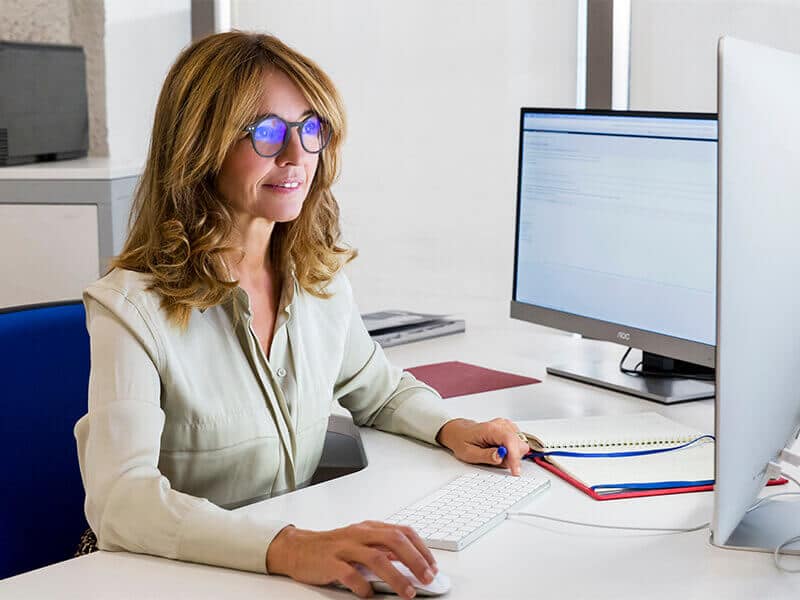Have you ever wondered if you wear the correct lenses for work? It is common for those who wear ‘corrective’ or ‘correction’ glasses to wear them throughout the day, both for indoor and outdoor activities with movement and for sitting working in front of a computer. But is it correct? … Keep reading this article to know the difference.
Corrective glasses, always the same?
Prescription glasses are our allies to help us improve visual acuity when our eyes suffer from refractive errors such as myopia (which prevents us from seeing well from afar), hyperopia (difficulty seeing well up close), astigmatism (which affects the near and distant vision, seeing in a distorted way) and presbyopia, a natural aging condition that usually appears after the age of 40 and that generates progressive loss of near vision.
Now, usually they will make us custom glasses to correct these defects and that we can move without problems during the different activities that we do during the day. The point is that not all the activities that we carry out will impose the same visual demand for our eyes. It is not the same to be in motion, to see from a distance, to see closely or to find ourselves static in front of a screen during the workday.
Lentes ergonómicas, pensadas según la actividad del usuario
It happens that the crystalline lens, our natural lens inside the eyeball, will accommodate itself according to the need for focus that depends on the distance where what we want to see is located. If we work seated 50cm from a computer screen, at a desk, we will require our eyes to focus on near and intermediate vision for a long time; It is likely that we are using glasses that actually help us to see well in near and / or far vision, but not specific for this type of activity in particular. This sometimes supposes a greater effort of vision for many users, especially those where presbyopia is present, which can be one of the causes of visual fatigue.
For this reason, occupational lenses have been created, indicated for presbyopic users, with an ergonomic design, specifically designed for jobs in which there is a great need for near and intermediate vision, with or without the use of electronic devices such as office work, kitchen, painting, hairdressing, etc. They are progressive lens designs, partly renouncing far vision, to provide a large field of near and intermediate vision. Let’s now see the types of occupational lenses and their functionality:
- Lentes ocupacional Office: indicada para usuarios con gran exigencia en visión próxima e intermedia, pero que al tener una profundidad de campo de 10m permiten gran libertad de movimiento.
- Lentes ocupacional Zoom: estas lentes a diferencia de las otras tienen una profundidad de campo más corta, variable entre 133 cm, 200 cm y 400 cm. Por este motivo están indicadas para usuarios que necesitan un campo de visión máximo de 4 metros o con actividades más estáticas. Por ej. Informáticos.
- Monofocal Relax: son lentes indicadas para usuario de 18 a 45 años con gran exigencia de visión próxima, que suelen sufrir al final de un largo día molestias o fatiga visual. Su función es ayudar a disminuir el esfuerzo acomodativo diario gracias a una muy pequeña adición de graduación. (Esta la pondría fuera del apartado de lentes ocupacionales, ya que, no lo es). Presentarla a parte como lente monofocal con ‘ayuda’ para trabajos de visión próxima/intermedia.

Keep in mind that it is also recommended, if you spend more than 3 hours in front of screens every day, that the lenses have a blue light filter treatment to avoid overexposure to it, which can be another cause of visual fatigue, and irregularities in rest, among others
Now you know the different ergonomic lens options for custom-made adjustable protective glasses, specific for different work environments such as the office and designed with the activity that the user will perform at work and the distance between the elements with which they interact are located. Not only will it improve the quality and visual comfort, but also the posture, since it avoids us getting close to the screen, providing the best and most ergonomic work environment.
Preguntas frecuentes sobre Lentes ergonómicas
What are occupational lenses?
They are progressive lenses, specifically designed for jobs in which there is a great need for near and intermediate vision and that partially renounce distant vision. There are different types of lenses optimized occupations according to the activity that the user is going to develop.
¿Cuándo es recomendable utilizar lentes ocupaciones?
When you need corrective glasses and for your daily work activity, make intensive use of near and intermediate vision and not so much of distant vision, such as for those who use office glasses and work in front of the computer. If your work is also quite static, there are Zoom Occupations lenses and if on the contrary you are more active, Offfice Occupations lenses. For young people between 18 and 45 years old, who make intensive use of devices, there are Relax Monofocals that will help the eye to fatigue less.
¿Me protegen las lentes ocupacionales de la luz azul?
It is recommended that occupational lenses be treated with a blue light filter if they are to be used to spend long hours in front of the computer. This filter will help prevent overexposure to blue light, which can be one of the causes of eyestrain.
